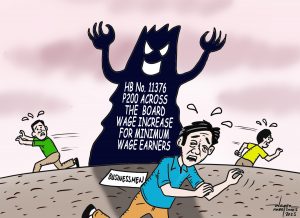
ON ONE occasion, I shared Daly’s impossibility theorem with my environmental economics class. And with my readers’ indulgence, allow me to share the idea here.
The concept is named after Herman Daly, an American ecological economist who maintained that growth has limits and that it is impossible to grow without hurting the environment.
The theorem stands on the statements of impossibility like “one cannot travel faster than light, nor one can destroy and create matter.”
The theorem warns that projects and human endeavors will fail when impossibilities are not considered.
Daly’s impossibility theorem talks about the order in the environment. The order, built upon principles, is ever-present, older than time and humankind.
In the ecological hierarchy, there will always be those at the bottom and those at the top.
In the language of economy and environment, it means that growing out of poverty is impossible without considering environment.
This theorem manifests in the present setup—the big drama of human expansion and population explosion.
When humans expand to cover land-based ecosystems for consumption, the effect is the reduction of the productive capacities of the land.
The irony is that the process of producing more leads to a decrease in productive capacities, hence, less output.
Such is the situation in Mindanao in the last 60 years. In fact, the Mindanao 2020 Peace and Development Framework crafted by the Mindanao Development Authority describes and lay out solutions to address the environment-economy tradeoff, which had been pervasive in the resource use patterns. It had been progress at the cost of environmental degradation.
The compromise between the economy and the environment results in unsustainable agricultural practices accelerating the balding of the forests, mining activities without environmental safeguards, and overfishing and destruction of natural fishing grounds.
Daly’s impossibility theorem reminds us that if growth is made sustainable, it has to focus on alleviating poverty. Development should take effect at the bottom.
When growth is a target, it is logical to avoid activities that shrink the potential of natural resources. The civic-oriented economic interventions need to focus on the poor, and let the market work for the rest.
Activities, therefore should be to produce food, clothing, shelter, clean water, better education, energy consumption, transportation and road network, public safety, order, and protection of property rights.
Mindanao is moving towards this trajectory.
Mindanao is in the middle of achieving inclusive growth by supporting and recognizing traditional and indigenous knowledge, increasing economies of scale, value-adding projects, achieving technical efficiencies, facilitating modernization of governance systems, and creating propulsions that raise Mindanao’s attractiveness and competitiveness.
Impressive advancements characterize Mindanao’s recent six years. Mindanawons can attest to this, and everybody is hopeful that the new administration sustains it.
(Adrian Tamayo is the head of the Public Relations of the Mindanao Development Authority (MinDA). He teaches economics at the Graduate School of the University of Mindanao and currently on a scholarship grant for Master of Public Safety Administration (MPSA) at the Philippine Public Safety College).



